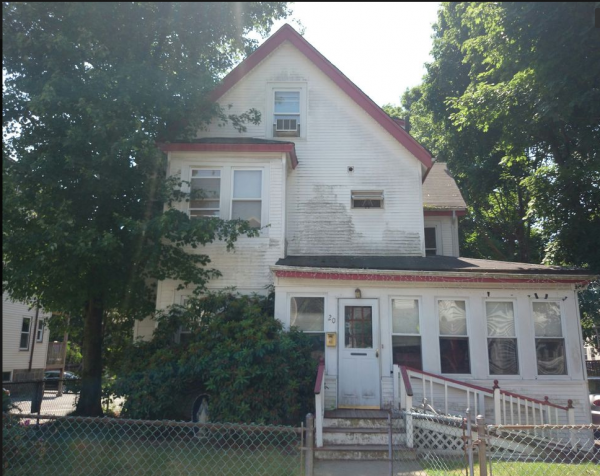February 9, 2017

The existing single-family house at 20 Fuller St.
A Zoning Board of Appeals decision that has green-lighted the demolition of a single-family home to clear the way for a three-story building with six apartments in Ashmont has caused waves in community meetings throughout Dorchester, with residents raising questions about how the city is approaching adding density in residential neighborhoods.
The project at 20 Fuller St. passed by a 6-2 vote last Tuesday with considerations built in: The builder, James O’Sullivan, must try to move the building’s main entrance from the side to the front, and he will need to work with the Boston Planning and Development Agency (BPDA) on the building’s “contextualism” with the surrounding two- and three-family homes.
O’Sullivan was before the zoning board to request variances on density and parking. In the middle of a two-family zone, the 8,579-square-foot lot is zoned as a single-family parcel. Parking requirements mandate seven and a half off-street parking spaces for the four three-bedroom units and two two-bedroom units, although the project plan only includes six spaces.
Making exceptions on parking requirements for housing near transit lines makes sense in theory, City Councillor Andrea Campbell said, but it does not help if there isn’t a broader effort to encourage residents to give up cars. Campbell told the Reporter that her office chose to remain neutral on the Fuller Street project out of consideration for surrounding community members who did not fall within the 300-foot abutter radius.
“Although there was a few [more votes] on the majority side, a lot of the folks who opposed it were also abutters or they were just outside the line by a house, by two houses,” she said. “So if we opened the line by a half-inch, we found that those who opposed it, it literally would have been split or close to it. So we said, this isn’t right. These folks are just outside but they still live in this neighborhood.”
Neelia Jackson, one of the neighbors who opposes the demolition, called the ZBA decision “extremely disappointing and frustrating” to “so easily grant approval of variances requested that significantly alter the face of the street”— especially in light of other high-density projects that are now in development along Dorchester Avenue.
“For what purposes is the ZBA… not upholding the zoning codes that they instituted? Their own zoning codes are not protecting this neighborhood,” Jackson wrote in a statement posted on the Reporter’s website, DotNews.com.
Another nearby resident, Shelly Goehring, was similarly concerned.
“With 147 units of housing being built just a few doors away from 20 Fuller, this added density and massing is simply unfair. And it sets a precedent that tearing down single-family houses, protected by zoning, is okay by the ZBA. Sadly, realtors take note,” said Goehring.
The decision reverberated on the other end of Dorchester Avenue this week. Members of the Columbia-Savin Hill Civic association discussed the development during their recent monthly meeting. One member called the report “disturbing,” particularly with regard to the comment made by Board of Appeals member Anthony Pisani, who said ensuring the building doesn’t stand out like a sore thumb is especially important for “what it may portend for future projects similar to this one” on the side streets off Dorchester Avenue.
David Cotter, the mayor’s liaison to Dorchester, was pressed for answers at the Columbia-Savin Hill meeting on whether the ZBA vote should be seen as precedent-setting. “Does the city have a policy of allowing single family houses near main arteries to be demolished in favor of condo developments or apartment building developments?” one member asked him.
Not specifically, Cotter answered, adding that neighbors can also seek relief from the city’s Landmark Commission to review a property’s historical significance before demolition. But, Cotter said, “there’s nothing to stop someone from demolishing the single-family that they are proposing.”
The city is not currently considering alterations to zoning that would prevent similar situations, he added.
The system creates “a perverse incentive to demolish single family houses,” another member said. “Because you could obviously get more money for a single family house that could be redeveloped as an apartment building.”
Single- and multi-family house conversions and demolitions around the neighborhoods in favor of small-scale, increased density are ramping up strains on parking and space, said civic member Bruce Shatswell. “The issue is not about buyers, because you can find somebody to pay a lot of money for not a lot of space,” he said. “It’s about the density of the area, the quality in the area, and how much traffic and how many residential units will fit and work.” Cotter noted that the developer submitted 30 signatures from abutters in favor of the proposal, which the mayor’s office supported.
Councillor Campbell is planning to host a meeting in the spring that would bring several civic groups together to discuss a local approach to development. “I often tell my constituents, ‘you may have these ideas about development,’ ” Campbell said, “but ‘some other people don’t share the same feelings about density, parking, design. They’re okay.’ ’’ So how do we have a conversation where we’re all understanding each other, so when I’m going before the BPDA, I’m not feeling like I have to take one side or the other.”
Villages:
Topics:



